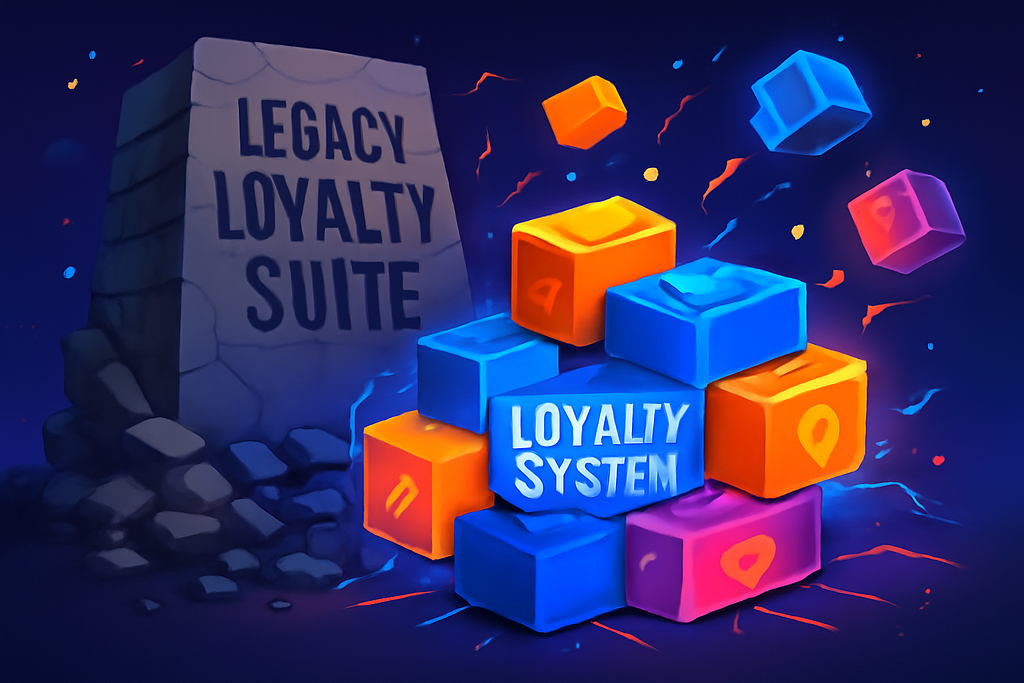Composable Loyalty Is Eating the Monoliths and How Modular Systems are the reasons
Introduction
For years, loyalty was boxed into one of two options: buy a heavy-duty suite like Salesforce, Oracle, or Capillary, or build something in-house. These all-in-one solutions promised scale but delivered rigidity, slow updates, and hefty costs. Brands were forced to fit into a pre-made framework that didn’t adapt to their evolving needs. Now, composable loyalty is challenging this model, offering brands modular systems that can be customized, updated, and scaled with speed and precision. It’s time to stop building loyalty with monoliths and start embracing the flexibility of composable systems.

The Loyalty Suite Is Cracking
Traditional loyalty suites promised everything in one box: CRM, CDP, CMS, and analytics. But what brands quickly learned was that the all-in-one promise came with significant limitations. These legacy systems often involved:
- Rigid rule engines: Hard to customize.
- Sky-high costs: Paying for features you don’t need or use.
- Slow to evolve: Updates and new features were dependent on vendor roadmaps, not the brand’s specific needs.
The result? Brands were forced to sacrifice flexibility for the sake of convenience, leaving them stuck with outdated systems that didn’t meet the demands of modern loyalty.
The New Stack: Composable, Modular, Interoperable
Composable loyalty flips the script. Instead of being locked in to a monolithic suite, brands can now choose modular tools that can be plugged into a broader loyalty stack. This flexibility gives brands the ability to build a loyalty system that suits their unique needs, without the constraints of a one-size-fits-all solution. A composable system typically includes:
- Journey orchestration tools (e.g., Braze)
- Behavioral data platforms (e.g., Segment)
- Reward and XP systems (e.g., Quboid)
- UX design platforms (e.g., Notion)
- Cross-platform reward systems (e.g., Telegram, Discord)
By choosing the best tools for their brand, companies can design and adapt their loyalty programs with speed and precision. And when a brand wants to change or upgrade one part of the system, they don’t need to overhaul everything—just swap out the individual tools they want to update.
Why Composable Loyalty Works
The key to composable loyalty is flexibility. The best composable loyalty systems offer five major advantages:
- Speed: With modular tools, brands can quickly launch new loyalty programs or features without waiting for long development cycles.
- Control: You design your own UX. You choose which actions count toward loyalty rewards and how those rewards evolve over time.
- Interoperability: Composable stacks thrive in multi-brand ecosystems. Users can earn rewards in one context and redeem them in another.
- Data Ownership: You get to decide what data you track, where to store it, and how to respond.
- Cost Efficiency: Composable systems allow you to pay for the tools you actually use.
The Flexibility of the Composable Approach
- Build What You Need: Use only what drives your loyalty strategy.
- Adapt Fast: Make changes anytime—no need to wait for vendor updates.
- Scale Easily: Grow your stack as your business grows.

The Business Philosophy Behind Composability
Composable loyalty is not just a technical shift—it’s a philosophical one. The traditional loyalty landscape was about centralized infrastructure and siloed tools. In contrast, composable loyalty is about flexible interfaces, allowing brands to create a loyalty program that’s entirely tailored to their specific needs. Brands that embrace this shift view loyalty not just as a backend system, but as a dynamic interface that reflects the brand’s identity and vision. As a16z notes, "Loyalty systems are no longer a back-end integration but a customer-facing interface."
Proof in the Market
Major brands are already embracing composable loyalty systems:
- Duolingo: Modular XP-based system that evolves with user behavior.
- Shopify: Brands use external loyalty/gamification APIs to customize.
- Reddit: Karma and avatars are modular, gamified systems.
- Starbucks Odyssey: Built on Polygon, with modular reward components.
The Real Benefit of Composability: Flexibility
With composable systems, brands can:
- Design custom loyalty workflows.
- Tailor rewards to behavior.
- Adapt quickly and test new formats.
Quboid’s Role in Building Composable Loyalty
Quboid offers a powerful solution for brands looking to build composable loyalty programs. Through its Qurious AI, Quboid helps brands implement modular reward systems that respond to user behavior in real-time. Whether it’s gamified streaks, mission-based rewards, or XP systems, Quboid makes it easy for brands to design loyalty systems that are not tied to a monolithic suite. By enabling cross-brand interoperability, Quboid’s platform ensures that rewards can be seamlessly shared between partners, providing a truly interoperable loyalty ecosystem.
Sources
- a16z, “Unbundling Loyalty: From Platforms to Protocols” (2024)
- McKinsey & Co, “Why Agile Brands Win Customer Retention” (2023)
- Braze, “Customer Engagement Benchmark Report” (2024)
- Shopify Dev Docs, “Building Custom Loyalty Workflows Using APIs”


